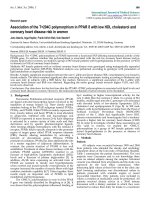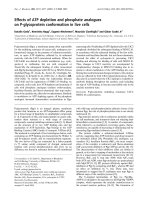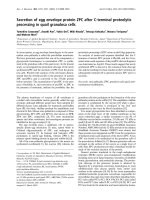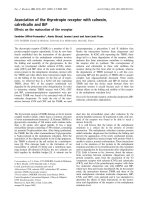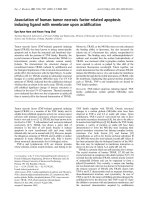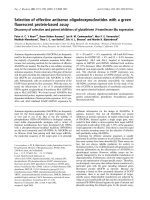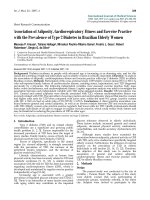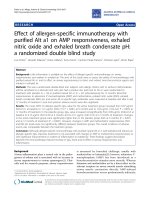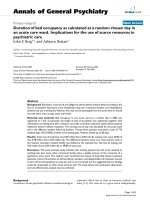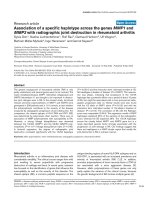Báo cáo y học: "Association of reduced heme oxygenase-1 with excessive Toll-like receptor 4 expression in peripheral blood mononuclear cells in Behçet''''s disease" potx
Bạn đang xem bản rút gọn của tài liệu. Xem và tải ngay bản đầy đủ của tài liệu tại đây (621.54 KB, 10 trang )
Open Access
Available online />Page 1 of 10
(page number not for citation purposes)
Vol 10 No 1
Research article
Association of reduced heme oxygenase-1 with excessive Toll-like
receptor 4 expression in peripheral blood mononuclear cells in
Behçet's disease
Yohei Kirino
1
, Mitsuhiro Takeno
1
, Reikou Watanabe
1
, Shuji Murakami
1
, Masayoshi Kobayashi
1
,
Haruko Ideguchi
1
, Atsushi Ihata
1
, Shigeru Ohno
1
, Atsuhisa Ueda
1
, Nobuhisa Mizuki
2
and
Yoshiaki Ishigatsubo
1
1
Department of Internal Medicine and Clinical Immunology, Yokohama City University Graduate School of Medicine, 236-0004, 3-9 Fukuura,
Kanazawa-ku, Yokohama, Japan
2
Department of Ophthalmology and Visual Science, Yokohama City University Graduate School of Medicine, 236-0004, 3-9 Fukuura, Kanazawa-ku,
Yokohama, Japan
Corresponding author: Yoshiaki Ishigatsubo,
Received: 25 Jul 2007 Revisions requested: 30 Aug 2007 Revisions received: 6 Nov 2007 Accepted: 31 Jan 2008 Published: 31 Jan 2008
Arthritis Research & Therapy 2008, 10:R16 (doi:10.1186/ar2367)
This article is online at: />© 2008 Kirino et al.; licensee BioMed Central Ltd.
This is an open access article distributed under the terms of the Creative Commons Attribution License ( />),
which permits unrestricted use, distribution, and reproduction in any medium, provided the original work is properly cited.
Abstract
Introduction Toll-like receptors (TLRs) mediate signaling that
triggers activation of the innate immune system, whereas heme
oxygenase (HO)-1 (an inducible heme-degrading enzyme that is
induced by various stresses) suppresses inflammatory
responses. We investigated the interaction between TLR and
HO-1 in an inflammatory disorder, namely Behçet's disease.
Methods Thirty-three patients with Behçet's disease and 30
healthy control individuals were included in the study.
Expression levels of HO-1, TLR2 and TLR4 mRNA were
semiquantitatively analyzed using a real-time PCR technique,
and HO-1 protein level was determined by immunoblotting in
peripheral blood mononuclear cells (PBMCs) and
polymorphonuclear leukocytes. In some experiments, cells were
stimulated with lipopolysaccharide or heat shock protein-60;
these proteins are known to be ligands for TLR2 and 4.
Results Levels of expression of HO-1 mRNA were significantly
reduced in PBMCs from patients with active Behçet's disease,
whereas those of TLR4, but not TLR2, were increased in
PBMCs, regardless of disease activity. Moreover, HO-1
expression in PBMCs from patients with Behçet's disease was
repressed in the presence of either lipopolysaccharide or heat
shock protein-60.
Conclusion The results suggest that upregulated TLR4 is
associated with HO-1 reduction in PBMCs from patients with
Behçet's disease, leading to augmented inflammatory
responses.
Introduction
Behçet's disease (BD) is an inflammatory disorder of unknown
cause, characterized by recurrent oral aphthous ulcers, genital
ulcers, uveitis, and skin lesions [1]. A close association of the
human leukocyte antigen (HLA)-B51 allele with the disease
suggests that genetic predisposition contributes to suscepti-
bility to BD [2]. In addition, infections with agents such as her-
pes simplex virus [3,4] and Streptococcus sanguis [5] has
been implicated in the development of BD, although no spe-
cific infectious agent has been identified as its cause [6].
Rather, several reports have suggested that ubiquitous anti-
gens presented by micro-organisms, such as heat shock pro-
teins (HSPs), trigger crossreactive autoimmune responses
through molecular mimicry machinery, which results in BD [6].
Not just acquired but also innate immune systems are acti-
vated in BD, because hyperfunction of neutrophils is a hall-
mark of the disease [7]. However, the immunopathological
mechanisms remain uncertain. Toll-like receptors (TLRs),
which are expressed on phagocytes and other cells, recognize
BD = Behçet's disease; GAPDH = glyceraldehyde-3-phosphate dehydrogenase; HLA = human leukocyte antigen; HO = heme oxygenase; HSP =
heat shock protein; LPS = lipopolysaccharide; PBMC = peripheral blood mononuclear cell; PCR = polymerase chain reaction; PMN = polymorpho-
nuclear leukocyte; RA = rheumatoid arthritis; TLR = Toll-like receptor; TNF = tumor necrosis factor.
Arthritis Research & Therapy Vol 10 No 1 Kirino et al.
Page 2 of 10
(page number not for citation purposes)
'pathogen-associated molecular patterns' in microbes and
mediate inflammatory signal transduction [8,9]. TLR2 and
TLR4 recognize lipoproteins and lipopolysaccharide (LPS),
respectively. Furthermore, both receptors also bind to the
endogenous 60 kDa HSP (HSP60), leading to cell activation
[10,11]. It is becoming clear that TLRs are involved in systemic
autoimmune disorders, because it was recently demonstrated
TLR2 and TLR4 are involved in rheumatoid arthritis (RA) [12-
14] and TLR9 in systemic lupus erythematosus [15,16]. These
findings have led to the hypothesis that microbial antigens not
only trigger autoimmune responses through specific T-cell
receptors but they also activate the innate immune system
through the TLRs, leading to the inflammation that is charac-
teristic of BD [17].
Few studies have been conducted to investigate the role
played by the regulatory systems in inflammatory diseases of
humans, including BD. We are interested in heme oxygenase
(HO)-1, because accumulating evidence suggests that HO-1
protects the host in a variety of pathologic conditions [18,19].
Our laboratory has demonstrated the beneficial role of HO-1
in inflammatory lung disease [20] and lupus nephritis [21]. On
the other hand, a deficiency in HO-1 expression is associated
with severe chronic inflammation, as demonstrated by studies
conducted in HO-1 knockout mice [22] and observations in a
patient with HO-1 deficiency [23]. These findings are consist-
ent with the notion that HO-1 plays a physiologic role in pro-
tecting against inflammation. Furthermore, our recent studies
[24-26] have demonstrated substantial pathologic roles of
HO-1 in rheumatic diseases. Abundant expression of HO-1
was identified in synovial tissues of patients with RA, in the
absence of elevated serum HO-1 levels [24,25]. Further anal-
ysis using RA synovial cell lines suggests that HO-1 plays a
regulatory role in RA inflammation [25]. Our recent study [26]
showed that tumor necrosis factor (TNF) suppresses HO-1
expression in human monocytes, leading to augmentation of
inflammatory responses, and that clinical efficacy of anti-TNF
therapy is associated with restoration of HO-1 expression in
circulating monocytes from patients with RA [26]. In another
study [20], HO-1 gene therapy successfully ameliorated lung
injury induced by LPS, which stimulates the innate immune
system through TLR4. It is thus of interest to study the relation-
ship between TLRs, as activating factors, and HO-1, as a reg-
ulatory factor of inflammatory responses in inflammatory
disorders.
In the present study, mRNA expression levels of HO-1, TLR2,
and TLR4 in circulating leukocytes from BD patients were
determined. The data suggest that activation signals through
essentially over-expressed TLR4 cause reduction in HO-1
expression in peripheral blood mononuclear cells (PBMC),
resulting in an augmentation of inflammatory responses in BD.
Materials and methods
Patients and healthy donors
Thirty-three patients with BD, who met the International Study
Group criteria for diagnosis of BD [27], were enrolled in the
study. Their mean age was 47.7 ± 15.0 years, and 13 were
male and 20 were female.
All of the patients were under the care of the Yokohama City
University Hospital. As previously described [28], 13 patients
with one or more lesions (including genital ulcers, uveitis, ery-
thema nodosum, arthritis, gastrointestinal lesions, central nerv-
ous system lesions, and/or C-reactive protein >10 mg/l) were
regarded to have active disease during the study.
The patients had been treated with a combination of the fol-
lowing agents: colchicines (17 patients), corticosteroids (13
patients), nonsteroidal anti-inflammatory drugs (14 patients),
sulfasalazine (two patients), and cytotoxic drugs such as meth-
otrexate (one patient), cyclosporine (four patients), tacrolimus
(one patient) and cyclophosphamide (one patient). Thirty
healthy age- and sex-matched individuals were also included
as a control group. HLA-B type was determined by SRL Inc.
(Tokyo, Japan) using lymphocyte cytotoxicity assay or a PCR
reverse sequence specific oligonucleotides method. All exper-
iments were conducted after written informed consent has
been obtained, which was approved by the local institutional
review board.
Reagents
Reagents were obtained from the following manufactures:
recombinant human TNF-α (R&D; Minneapolis, MN, USA),
polymyxin B and LPS Escherichia coli O111: B4 (Calbio-
chem; La Jolla, CA, USA), low endotoxin recombinant human
HSP60 (Stressgen; Victoria, Canada), and IgG
1
κ (Serotech;
Oxford, UK). Infliximab was kindly provided by Tanabe Seiyaku
(Osaka, Japan).
Cell preparation and culture
PBMCs and polymorphonuclear leukocytes (PMNs) were iso-
lated by centrifugation over two Ficoll-Hypaques gradients of
specific gravities 1.077 (ICN; Aurora, OH, USA) and 1.119
(Nacalai; Kyoto, Japan). Purity of the separated neutrophils,
which were determined by flow cytomeric scattergram, was
typically above 97% [7]. Monocytes were negatively selected
by magnetic cell sorting (Miltenyi Biotec; Gladbach, Germany)
using a monocyte isolation kit (Miltenyi Biotec). More than
95% of the obtained monocytes expressed CD14, based on
flowcytomeric analysis [26].
The cells were incubated in hepes modified RPMI1640
(Sigma-Aldrich; Saint Louis, MO, USA) containing 10% fetal
calf serum (Equitech-bio; Kerrville, TX, USA), 2 mmol/l L-
glutamine (Sigma-Aldrich), 100 U/ml penicillin plus 100 μg/ml
streptomycin (Sigma-Aldrich) in a 5% carbon dioxide in an air
incubator at 37°C. To determine HO-1 expression at mRNA
Available online />Page 3 of 10
(page number not for citation purposes)
and protein levels, cells were cultured in the presence or
absence of LPS (10 ng/ml) or HSP60 (3 μg/ml) for 6 to 24
hours.
Transfection
Purified monocytes (1 × 10
6
) were transfected with 3 μg of
human HO-1 expression vector or control vector by using
Nucleofector (Amaxa Biosystems; Gaithersburg, MD, USA)
and human monocyte Nucleofector kit (Amaxa Biosystems)
[25,26]. Twenty four hours later, the cells were used for further
experiments.
Reverse transcription PCR and Real-time PCR
Total RNA was isolated from cells with TRIzol reagent (Invitro-
gen, Carlsbad, CA, USA) [21,24-26]. One microgram of total
RNA served as a template for single-stranded cDNA synthesis
in a reaction using oligo (dT) primers and SuperScript II (Invit-
rogen). For the reverse transcription PCR, 1 μl cDNA was
incubated with 9.375 μl de-ionized distilled water, 2 μl dNTP,
2.5 μl 10 × PCR buffer, 0.125 μl Taq polymerase (Takara,
Ohtsu, Japan), and primer pairs for target genes. The primers
used in the study are summarized in Table 1.
Cycling conditions included 35 cycles of amplification for 30
seconds at 94°C, 30 seconds at 55°C, 1 minute at 72°C, and
a final extension phase consisting of one cycle of 10 minutes
at 72°C. The primers and probes for human HO-1, TLR2,
TLR4, CD14, TNF-α, MD-2 (Myeloid differentiation factor-2),
and glyceraldehyde-3-phosphate dehydrogenase (GAPDH)
used in the real-time PCR were purchased from PE Applied
Biosystems (Foster City, CA, USA). Real-time PCR was per-
formed using a BD Qtaq DNA polymerase (BD Bioscience),
and the data were analyzed by the ABI prism 7700 sequence
detection system (PE Applied Biosystems, Franklin Lakes, NJ,
USA). Briefly, 1/50 of cDNA derived from 1 μg total RNA, 200
nmol/l probe, and 800 nmol/l primers were incubated in 25 μl
at 50°C for 2 minutes and 95°C for 10 minutes, followed by
40 cycles of 95°C for 15 seconds and 60°C for 1 minute. The
analysis system determined the number of cycles at which the
amplified DNA in the sample exceeded the threshold during
the PCR. Gene expression levels of the individual samples
were calculated on standard curves of each cDNA generated
by serial dilutions of the PCR amplified products. The data on
HO-1, TLR2, TLR4, and TNF-α were standardized to the
expression of GAPDH in the same samples, using multiplex
PCR technique. Expression level of HO-1 mRNA in a sample
is indicated as arbitrary units.
Immunoblot analysis
The expression of HO-1 protein was determined by immunob-
lotting as described previously [25]. Briefly, cells were treated
with lysis buffer (137 mmol/l NaCl, 20 mmol/l Tris-HCl, 50
mmol/l NaF, 1 mmol/l EDTA, and Triton-X), supplemented with
a protease inhibitor cocktail (Sigma-Aldrich) for 30 minutes on
ice, and the supernatants were recovered by centrifugation at
15,000 rpm for 30 minutes. For TLR2 and TLR4 immunoblot-
ting, after addition of lysis buffer, cells were homogenized for
15 minutes by ultrasonifier (Branson Japan, Kanagawa,
Table 1
Primers used in the study
Primer Sense/antisense Sequence
HO-1 Sense CAGGCAGAGAATGCTGAG
Antisense GCTTCACATAGCGCTGCA
TLR2 Sense TGACTGCTCGGAGTTCTCCC
Antisense GTCAGCACCAGAGCCTGGAG
TLR4 Sense GCGGCTCGAGGAAGAGAAGA
Antisense AGGCTCTGATATGCCCCATC
GAPDH Sense ACAGTCAGCCGCATC
Antisense AGGTGCGGCTCCCTA
TNF-α Sense ATGAGCACTGAAAGCATGATC
Antisense GGCGATGCGGCTGATGGT
CD14 Sense CGGCCGAAGAGTTCACAAGT
Antisense AGTGCAGTCCTGTGGCTTC
MD-2 Sense TAAATCTTTTCTGCTTACTGA
Antisense TACTCAATTTATTCTAATTTGAAT
HO, heme oxygenase; MD, Myeloid differentiation factor-2 ; TLR, Toll-like receptor; TNF, tumor necrosis factor; GAPDH, glyceraldehyde-3-
phosphate dehydrogenase.
Arthritis Research & Therapy Vol 10 No 1 Kirino et al.
Page 4 of 10
(page number not for citation purposes)
Japan). The samples were resolved electrophoretically on a
4% to 20% gradient of polyacrylamide gel (Daiichi Kagaku,
Tokyo, Japan) and transferred onto a polyvinyldene difluoride
membrane (Millipore, Billerica, MA, USA). After blocking with
5% skimmed milk/Tris-buffered saline overnight at 4°C, the
membrane was incubated with optimally diluted anti-HO-1
monoclonal antibody (Stressgen), anti-TLR2 and anti-TLR4
(Imgenex, San Diego, CA, USA) monoclonal antibody, or anti-
actin goat polyclonal antibody (Santa Cruz Biotechnology,
Santa Cruz, CA, USA) for 1 hour at room temperature or over-
night at 4°C, and subsequently for 45 minutes with horserad-
ish peroxidase-conjugated anti-mouse secondary antibody
(Amersham Life Sciences, Piscataway, NJ, USA) or rabbit anti-
goat IgG horseradish peroxidase conjugate (Zymed, South
San Francisco, CA, USA). The signals were developed by
using the enhanced chemiluminescence detection system
(Amersham Life Sciences). The amount of blotted protein was
measured densitometrically by using Scion image analysis and
image processing software (NIH Image Engineering,
Bethesda, MD, USA).
Statistical analysis
Mann-Whitney U-test, Kruskal-Wallis test with post-hoc
Scheffe's test, paired t-test, and regression analysis were used
to test for differences. P values less than 0.05 were consid-
ered statistically significant.
Results
Reduced HO-1 mRNA expression in PBMCs from
patients with active BD
HO-1 mRNA expression level was determined in circulating
leukocytes from BD patients by using a real-time PCR tech-
nique (Figure 1). A good correlation between HO-1 mRNA
and protein levels has been demonstrated [26]. Consistent
with previous findings [24], we found no significant difference
in HO-1 mRNA expression in PBMCs between BD patients
(including both patients with active and those with inactive dis-
ease) and healthy control individuals (data not shown). A more
detailed analysis based on disease activity, however, revealed
that PBMCs from patients with active BD, but not those with
inactive disease, expressed significantly lower HO-1 mRNA
levels than did PBMCs from healthy control individuals (Figure
1a). Because HO-1 is preferentially expressed by monocytes
among PBMCs, amounts of HO-1 mRNA may depend on the
proportion of monocytes detected [26]. CD14 mRNA levels
determined by real-time PCR were comparable between BD
and healthy control individuals, indicating that there was no dif-
ference between groups in the proportion of monocytes
among circulating leukocytes (data not shown). Moreover, no
significant difference was found in absolute counts of mono-
cytes between patients with active BD and those with inactive
disease (active 497.9 ± 218.8/μl versus inactive 462.7 ±
182.4/μl; P = 0.77, by Mann-Whitney U-test), indicating that
HO-1 expression was reduced in individual cells from patients
with active disease. As shown in Figure 1b, HO-1 mRNA lev-
Figure 1
HO-1 mRNA expression in PBMCs and PMNs from patients with BDHO-1 mRNA expression in PBMCs and PMNs from patients with BD. (a) Peripheral blood mononuclear cell (PBMC) heme oxygenase (HO)-1
mRNA expression in healthy controls (HC), and patients with active and inactive Behçet's disease (BD) were determined semiquantitatively by real-
time PCR. Horizontal bars represent mean values of HO-1 mRNA. (b) Polymorphonuclear leukocyte (PMN) HO-1 mRNA expression levels of HC,
and patients with active and inactive BD. *P < 0.05, as determined using the Kruskal-Wallis test with post-hoc Scheffe's test. AU, arbitrary unit;
GAPDH, glyceraldehyde-3-phosphate dehydrogenase; NS, not significant.
Available online />Page 5 of 10
(page number not for citation purposes)
els in PMNs were not significantly different between BD
patients and control individuals (Figure 1b).
No particular clinical manifestations, including ocular lesions
(Table 2) and treatments (data not shown), were associated
with the reduction in HO-1 mRNA expression in PBMCs.
There were no differences in mRNA expression levels of HO-
1 and TLRs between HLA-B51-positive and -negative patients
(Table 2). Levels of HO-1 mRNA expression were not altered
by treatment with colchicine or prednisolone in the patients
(data not shown).
Increased TLR4, but not TLR2, expression by PBMCs
from BD patients
Because HSP60 has been implicated in the pathogenesis of
BD [17], levels of mRNA for TLR2 and TLR4 (both of which
recognize HSP60 as a ligand) were examined in PBMCs and
PMNs from patients with BD (Figure 2). In preliminary experi-
ments, the relationship between levels of TLR mRNA and pro-
tein in circulating leukocytes was examined. Briefly, after
fractionating PBMCs into CD14-positive cells and CD14-
depleted cells by means of magnetic cell sorting, mRNA and
protein levels of TLRs were compared by using real-time PCR
and immunoblotting techniques, respectively. TLR4 was pref-
erentially expressed on CD14-positive cells, but not CD14-
depleted cells, at both mRNA and protein levels (Additional file
1). Moreover, TLR4 and TLR mRNA levels correlated well with
protein levels.
No significant differences were found in levels of TLR2 mRNA
expression in PBMCs between patients with active BD,
patients with inactive BD, and healthy control individuals (Fig-
ure 2a). On the other hand, TLR4 mRNA expression levels
were elevated in PBMCs from patients, irrespective of disease
activity (Figure 2b) and HLA-B51 phenotype (data not shown).
However, no significant differences in levels of mRNA expres-
sion for CD14 and MD-2, which are critically involved in LPS-
mediated signal transduction of TLR, were found between
patients and control individuals (data not shown). There was
no abnormality in mRNA expression of TLR2 and TLR4 in
PMNs (Figure 2c,d). The results indicate that TLR4 mRNA
expression is constitutively increased in PBMCs from BD
patients.
Inverse correlation between HO-1 and TLR4 mRNA in
PBMCs from BD patients
TLR4 signaling triggers activation of the innate immune sys-
tem, whereas HO-1 plays a regulatory role in inflammatory
response. Analysis of the relationship between the two mole-
cules showed that TLR4 mRNA was inversely correlated with
HO-1 mRNA in PBMCs from BD patients (Additional file 2; P
< 0.05, r = -0.42, by regression analysis). Because LPS (a
TLR4 ligand) has been shown to suppress interleukin-10-
dependent HO-1 expression in human PBMCs [29], it is plau-
sible that excessively expressed TLR4 contributes to defective
HO-1 expression in PBMCs from BD patients. As expected,
the immunoblotting study revealed that stimulation with LPS
reduced HO-1 expression in PBMCs from patients with BD,
irrespective of the presence or absence of interleukin-10 (Fig-
ure 3a). The suppressive effect on HO-1 expression was com-
pletely abrogated by a LPS neutrizer, namely polymyxin B
(Figure 3a). Similarly, real-time PCR analysis revealed a reduc-
tion in HO-1 mRNA levels in LPS-stimulated PBMCs (Figure
4a) when TNF mRNA expression was elevated (Figure 4b).
The magnitude of LPS-induced HO-1 suppression (calculated
as the gap in HO-1 mRNA between PBMCs subjected to 6
hours of LPS treatment and untreated PBMCs [ΔHO-1]) was
significantly correlated with TLR4 mRNA expression levels in
untreated PBMCs (Figure 4c).
In our previous study [26] we demonstrated that TNF enhances
HO-1 mRNA degradation, resulting in a reduction in HO-1
expression in human monocytes. Because TLR4 signaling leads
to synthesis of TNF, which may be involved in the reduction in
HO-1 expression in PBMCs from patients with BD. However,
levels of TNF mRNA did not correlate with those of HO-1 in
PBMCs from patients with BD (data not shown). Moreover,
although the preliminary experiments confirmed that 10 ng/ml
LPS efficiently stimulated PBMCs to produce substantial
amounts of TNF protein, anti-TNF-α antibody infliximab did not
eliminate the suppressive effect of LPS on HO-1 expression in
monocytes in vitro (Additional file 3). The findings indicated that
the effect is not solely dependent on TNF (Figure 3d).
Table 2
HO-1 mRNA expression in patients with BD
PBMCs/PMNs Ocular involvement HLA-B51
- (n = 17) + (n = 16) - (n = 10) + (n = 14)
HO-1 (AU) PBMCs 7.7 ± 3.1 5.7 ± 4.1 8.1 ± 3.9 5.6 ± 3.7
PMNs 32.9 ± 46.1 31.6 ± 34.1 31.6 ± 38.0 19.9 ± 18.0
Values are expressed as mean ± standard deviation. AU, arbitrary unit; BD, Behçet's disease; HLA, human leukocyte antigen; HO, heme
oxygenase; PBMC, peripheral blood mononuclear cells; PMN, peripheral blood multinuclear cells.
Arthritis Research & Therapy Vol 10 No 1 Kirino et al.
Page 6 of 10
(page number not for citation purposes)
No effect of forced HO-1 expression on TLR2 and TLR4
mRNA in human PBMCs
Because our previous study demonstrated bidirectory interac-
tions between HO-1 and TNF [26], we also examined effects
of HO-1 upregulation on TLR levels in monocytes. Over-
expression of HO-1 protein was confirmed by immunoblotting
analysis 24 hours after transfection with pHO-1 (human HO-1
expression vector) into monocytes. Under these conditions, no
differences were found in expression levels of TLR2 and TLR4
between HO-1 cDNA transfected monocytes and controls
(Figure 5). Taken together, our findings implicate the involve-
ment of excessive TLR4 expression in low levels of HO-1
mRNA expression in PBMCs from patients with BD.
Discussion
In the present study we found endogenous HO-1 expression
to be decreased in PBMCs from patients with active BD. Dys-
regulation of HO-1 expression is associated with some rheu-
matic diseases. Our previous studies [24,25] have
demonstrated elevated serum HO-1 levels in patients with
Figure 2
TLR2 and TLR4 mRNA expression in PBMCs and PMNs from patients with BDTLR2 and TLR4 mRNA expression in PBMCs and PMNs from patients with BD. Expression levels in peripheral blood mononuclear cells (PBMCs) of
(a) Toll-like receptor (TLR)2 and (b) TLR4 mRNA in healthy controls (HC), and patients with active and inactive Behçet's disease (BD) were deter-
mined semiquantitatively by real-time PCR. Horizontal bars represent mean values of HO-1 mRNA. Expression levels in polymorphonuclear leuko-
cytes (PMNs) of (c) TLR2 and (d) TLR4 in HC, and patients with active and inactive BD. *P < 0.05, **P < 0.01, as determined using the Kruskal-
Wallis test with post-hoc Scheffe's test. AU, arbitrary unit; GAPDH, glyceraldehyde-3-phosphate dehydrogenase; NS, not significant.
Available online />Page 7 of 10
(page number not for citation purposes)
adult onset Still's disease and hemophagocytic syndrome, and
aberrant expression of HO-1 in synoviocytes from patients
with RA. However, reduced HO-1 levels in leukocytes have
not been demonstrated in other rheumatic diseases. Evidence
suggests that increased expression of HO-1 can benefit the
host in a variety of pathologic conditions, including inflamma-
tory changes, whereas a deficiency in HO-1 expression is
associated with vigorous inflammation, as demonstrated by
studies of HO-1 knockout mice and observed in a patient with
HO-1 deficiency [22,23]. In RA, HO-1-expressing cells were
located in the lining and sublining layers, but not in the carti-
lage-pannus junction, where bone and cartilage are actively
destroyed [25,30,31]. Furthermore, our previous report [26]
demonstrated that selective knockdown of HO-1 expression
by using specific small interfering RNA resulted in upregula-
tion of synthesis of proinflammatory cytokines, including inter-
leukin-6, interleukin-8 and TNF, which have been shown to be
elevated in sera from BD patients [6]. This suggests that leu-
kocyte function is regulated by HO-1 expressed in the cells
[26]. Thus, defective expression of HO-1 may be involved in
the inflammation characteristic of BD, especially in patients
with active disease.
Although a pathogenic role of anti-HSP60 specific autoim-
mune responses has been suggested in BD, abnormal activa-
tion of the innate immune system has also been identified in
the disease [1,6]. Furthermore, involvement of TLRs has been
shown in other systemic autoimmune diseases [16]. In the
present study, expression levels of TLR2 and TLR4 were
examined because both TLRs recognize HSP60 as ligands
[10,11]. Actually, HSP60 was reported to be expressed in
PBMCs, and in intestinal and mucocutaneous lesions from BD
patients [32,33]. Our findings demonstrated that levels of
TLR4 mRNA, but not of TLR2 mRNA, are constitutively
increased in PBMCs from patients with BD, regardless of dis-
ease activity. The data suggest possible involvement of TLR4
in BD, although TLR4 has been also implicated in other rheu-
matic diseases [13,34]. Abnormal expression of TLR4 can
predispose to defective HO-1 expression in BD PBMCs,
because TLR4 may be a putative HO-1 repressor in hepatic
ischemia/reperfusion injury mouse model [35]. Indeed, HO-1
expression was suppressed in PBMCs stimulated with LPS
[29]. Moreover, elevated soluble CD14 in plasma of BD
patients may further facilitate LPS binding to TLR4 [36]. Inter-
estingly, LPS-induced lung injury in a mouse model was res-
cued by administration of an HO-1 adenovirus vector [20]; this
suggests that HO-1 supplementation may have utility as a
strategy for countering TLR4-related inflammation. Such a
strategy may also be applicable to BD.
TNF plays a critical role in the development of BD [1,37,38].
Several studies, including ours, have demonstrated that TNF is
excessively produced in patients with active BD [28,38].
Indeed, anti-TNF therapy is effective in the disease, especially
for management of ocular lesions [39]. In our previous study
[26] we showed that TNF suppresses HO-1 expression levels
in human peripheral monocytes, thereby accelerating inflam-
matory responses; this suggests that excessive TNF levels
contribute to defective HO-1 expression. However, no associ-
ation was found between HO-1 and TNF mRNA levels in cir-
Figure 3
Effects of HSP60 and LPS on HO-1 protein expression in PBMCs from patients with BDEffects of HSP60 and LPS on HO-1 protein expression in PBMCs from patients with BD. (a) Effect of lipopolysaccharide (LPS) stimulation on heme
oxygenase (HO)-1 and actin protein expression in peripheral blood mononuclear cells (PBMCs) from patients with Behçet's disease (BD). PBMCs
from a BD patient were stimulated with LPS in the presence or absence of 10 ng/ml interleukin (IL)-10 and 100 μg/ml polymyxin B (PMB). Repre-
sentative immunoblotting data for HO-1 protein in the cells are shown. The arrowhead indicates 32 kDa molecular weight HO-1 specific band. (b)
Effect of heat shock protein (HSP)60 (3 μg/ml) stimulation on endogenous HO-1 protein expression in PBMCs from patients with BD. The arrow-
head indicates 32 kDa HO-1 specific band. A representative of three independent experiments is shown. (c) Mean and standard error of the mean
(SEM) values of HO-1 and actin protein expression in PBMCs stimulated by LPS (1 ng/ml) for 24 hours in patients with BD (n = 14).
#
P < 0.001, as
determined using paired t-test. (d) Effect of infliximab (10 μg/ml) or IgG
1
κ (10 μg/ml) on HO-1 expression in LPS (10 ng/ml) or tumor necrosis factor
(TNF; 1 ng/ml) treated PBMCs.
Arthritis Research & Therapy Vol 10 No 1 Kirino et al.
Page 8 of 10
(page number not for citation purposes)
culating PBMCs from patients with BD. In addition, the
suppressive effect of LPS on HO-1 was not abrogated by anti-
TNF antibody, at least in vitro, although significant synthesis of
TNF in response to LPS was confirmed in the experiments
(Additional file 3). These data, rather, suggest that the effect of
LPS is mainly mediated by a pathway distinct from TNF. How-
ever, TNF may also contribute to defective HO-1 expression in
vivo, because other types of cells also produce TNF in BD.
Taken together, our findings suggest that highly expressed
TLR4 might contribute to reduced HO-1 expression, leading
to an activation of the innate immune system in BD, although
other factors including TNF may be involved in the defective
HO-1. Because TLRs other than TLR4 are also likely to be
involved in the pathogenesis BD [17], further investigation of
molecular mechanisms, including interactions between TLRs
and HO-1, are required, especially those that distinguish BD
from other inflammatory diseases.
Conclusion
Based on the data presented, we hypothesize that HSP60
stimulates not only antigen-specific autoimmune responses
but also the innate immune system through constitutively over-
expressed TLR4, which mediates HO-1 reduction in PBMCs,
leading to inflammation in BD. Restoration of HO-1 expression
might be a promising therapeutic strategy in the disease. Alter-
natively, specific intervention in TLR4-mediated signals that
lead to HO-1 reduction may also be of benefit in BD.
Competing interests
The authors have received no financial support or other bene-
fits from commercial sources for the work reported here, and
the authors have no other financial interests that could create
a potential conflict of interest or the appearance of a conflict
of interest with regard to the present study.
Authors' contributions
YI designed and organized the study. YK, MT, RW, SM, and
MK conducted the laboratory work. YK, MT, RW, SM, MK, AI,
HI, SO, AU, NM, and YI were involved in the analysis and inter-
pretation of data. YK, MT, and YI were involved in writing the
report. All authors read and approved the final manuscript. The
authors thank Mr Tom Kiper for his review.
Figure 4
Effect of LPS on HO-1 mRNA expression in PBMCs from BD patientsEffect of LPS on HO-1 mRNA expression in PBMCs from BD patients. Expression of (a) heme oxygenase (HO)-1 and (b) tumor necrosis factor
(TNF) mRNA in peripheral blood mononuclear cells (PBMCs) from patients with Behçet's disease (BD; n = 18). Values presented are mean and
standard error of the mean (SEM) change, regarding 1 to be the value of untreated cells.
#
P < 0.001, as determined using paired t-test. (c) Relation-
ship of endogenous Toll-like receptor (TLR)4 mRNA with gap in HO-1 mRNA between PBMCs subjected to 6 hours of treatment with lipopolysac-
charide (LPS) and untreated PBMCs (ΔHO-1). P = 0.02, r = 0.53, as determined by regression analysis. AU, arbitrary unit; GAPDH, glyceraldehyde-
3-phosphate dehydrogenase.
Available online />Page 9 of 10
(page number not for citation purposes)
Additional files
Acknowledgements
This work was supported in part by grants from The Yokohama City Uni-
versity Center of Excellence Program of the Ministry of Education, Cul-
ture, Sports, Science and Technology of Japan (Y Ishigatsubo),
Research on Specific Disease of the Health Science Research Grants
from the Ministry of Health, Labour, and Welfare (Y Ishigatsubo), and the
2006 Strategic Research Project No. K18006 from Yokohama City Uni-
versity (Y Ishigatsubo), and 2004–2005 grant-in-aid for scientific
research (project No. 16590991) from the Ministry of Education, Cul-
ture, Sports, and Technology of Japan (M Takeno), and 2005 (Y Kirino)
and 2006 (M Takeno) grants from the Yokohama Foundation for
Advancement of Medical Science. This study was also supported in part
by grants from the Kanagawa Nanbyo Foundation (Y Kirino). The source
of funding had no role in the writing of the report or the decision to pub-
lish the results.
References
1. Sakane T, Takeno M, Suzuki N, Inaba G: Behcet's disease. N
Engl J Med 1999, 341:1284-1291.
2. Ohno S, Ohguchi M, Hirose S, Matsuda H, Wakisaka A, Aizawa M:
Close association of HLA-Bw51 with Behcet's disease. Arch
Ophthalmol 1982, 100:1455-1458.
3. Sezer FN: The isolation of a virus as the cause of Behcet's
diseases. Am J Ophthalmol 1953, 36:301-315.
4. Lee S, Bang D, Cho YH, Lee ES, Sohn S: Polymerase chain
reaction reveals herpes simplex virus DNA in saliva of patients
with Behcet's disease. Arch Dermatol Res 1996, 288:179-183.
5. Anonymous: Skin hypersensitivity to streptococcal antigens
and the induction of systemic symptoms by the antigens in
Behcet's disease: a multicenter study. The Behcet's Disease
Research Committee of Japan. J Rheumatol 1989, 16:506-511.
6. Direskeneli H: Behcet's disease: infectious aetiology, new
autoantigens, and HLA-B51. Ann Rheum Dis 2001,
60:996-1002.
7. Takeno M, Kariyone A, Yamashita N, Takiguchi M, Mizushima Y,
Kaneoka H, Sakane T: Excessive function of peripheral blood
neutrophils from patients with Behcet's disease and from
HLA-B51 transgenic mice. Arthritis Rheum 1995, 38:426-433.
8. Akira S, Takeda K: Toll-like receptor signalling. Nat Rev
Immunol 2004, 4:499-511.
9. Kawai T, Akira S: Toll-like receptor downstream signaling.
Arthritis Res Ther 2005, 7:12-19.
10. Ohashi K, Burkart V, Flohe S, Kolb H: Cutting edge: heat shock
protein 60 is a putative endogenous ligand of the toll-like
receptor-4 complex. J Immunol 2000, 164:558-561.
11. Vabulas RM, Ahmad-Nejad P, da Costa C, Miethke T, Kirschning
CJ, Hacker H, Wagner H: Endocytosed HSP60s use toll-like
receptor 2 (TLR2) and TLR4 to activate the toll/interleukin-1
receptor signaling pathway in innate immune cells. J Biol
Chem 2001, 276:31332-31339.
12. Seibl R, Birchler T, Loeliger S, Hossle JP, Gay RE, Saurenmann T,
Michel BA, Seger RA, Gay S, Lauener RP: Expression and regu-
lation of Toll-like receptor 2 in rheumatoid arthritis synovium.
Am J Pathol 2003, 162:1221-1227.
13. Frasnelli M, So A: Toll-like receptor 2 and toll-like receptor 4
expression on CD64
+
monocytes in rheumatoid arthritis: com-
Figure 5
Effect of forced HO-1 expression on Toll-like receptor (TLR)2 and TLR4 mRNA expression in peripheral monocytesEffect of forced HO-1 expression on Toll-like receptor (TLR)2 and
TLR4 mRNA expression in peripheral monocytes. (a) Immunoblotting
analysis of heme oxygenase (HO)-1 and actin in pHO-1 (human HO-1
expression vector) or pCont (control vector) transfected monocytes.
The arrow represents HO-1 protein. (b) Real-time PCR analysis of
TLR2 and TLR4 mRNA expression in pHO-1 transfected peripheral
blood mononuclear cells (PBMCs). NS, not significant.
The following Additional files are available online:
Additional file 1
The Protein and mRNA TLR2, TLR4 and HO-1
expression levels in PBMCs. (A) TLR2, TLR4, HO-1, and
actin protein expression in PBMCs and CD14
+/-
cells
from a healthy control individual (HC). (b) TLR2, TLR4,
CD14, and β-actin mRNA expression levels in CD14
+/-
cells from HCs. (C) Correlation between
densitometrically analyzed HO-1 protein levels and
semiquantatively evaluated HO-1 mRNA expression by
real-time PCR in PBMCs and CD14
+/-
cells from a HC.
See />supplementary/ar2367-S1.TIFF
Additional file 2
The correlation between HO-1 and TLR4 mRNA levels in
PBMCs from patients with BD.
See />supplementary/ar2367-S3.TIFF
Additional file 3
The effect of LPS, PMB, and infliximab on TNF-α
production by PBMCs. TNF-α levels in supernatants of
PBMC-cultured media recovered after 24 hours of
stimulation with LPS, with or without PMB and/or
infliximab, as determined by ELISA.
See />supplementary/ar2367-S2.TIFF
Arthritis Research & Therapy Vol 10 No 1 Kirino et al.
Page 10 of 10
(page number not for citation purposes)
ment on the article by Iwahashi et al. Arthritis Rheum 2005,
52:2227-2228.
14. Iwahashi M, Yamamura M, Aita T, Okamoto A, Ueno A, Ogawa N,
Akashi S, Miyake K, Godowski PJ, Makino H: Expression of Toll-
like receptor 2 on CD16
+
blood monocytes and synovial tissue
macrophages in rheumatoid arthritis. Arthritis Rheum 2004,
50:1457-1467.
15. Papadimitraki ED, Choulaki C, Koutala E, Bertsias G, Tsatsanis C,
Gergianaki I, Raptopoulou A, Kritikos HD, Mamalaki C, Sidiropou-
los P, Boumpas DT: Expansion of toll-like receptor 9-express-
ing B cells in active systemic lupus erythematosus:
implications for the induction and maintenance of the autoim-
mune process. Arthritis Rheum 2006, 54:3601-3611.
16. Marshak-Rothstein A: Toll-like receptors in systemic autoim-
mune disease. Nat Rev Immunol 2006, 6:823-835.
17. Direskeneli H, Saruhan-Direskeneli G: The role of heat shock
proteins in Behcet's disease. Clin Exp Rheumatol 2003,
21:S44-S48.
18. Otterbein LE, Soares MP, Yamashita K, Bach FH: Heme oxygen-
ase-1: unleashing the protective properties of heme. Trends
Immunol 2003, 24:449-455.
19. Morse D, Choi AM: Heme oxygenase-1: the 'emerging mole-
cule' has arrived. Am J Respir Cell Mol Biol 2002, 27:8-16.
20. Inoue S, Suzuki M, Nagashima Y, Suzuki S, Hashiba T, Tsuburai T,
Ikehara K, Matsuse T, Ishigatsubo Y: Transfer of heme oxygen-
ase 1 cDNA by a replication-deficient adenovirus enhances
interleukin 10 production from alveolar macrophages that
attenuates lipopolysaccharide-induced acute lung injury in
mice. Hum Gene Ther 2001, 12:967-979.
21. Takeda Y, Takeno M, Iwasaki M, Kobayashi H, Kirino Y, Ueda A,
Nagahama K, Aoki I, Ishigatsubo Y: Chemical induction of HO-1
suppresses lupus nephritis by reducing local iNOS expression
and synthesis of anti-dsDNA antibody. Clin Exp Immunol 2004,
138:237-244.
22. Poss KD, Tonegawa S: Reduced stress defense in heme oxy-
genase 1-deficient cells. Proc Natl Acad Sci USA 1997,
94:10925-10930.
23. Yachie A, Niida Y, Wada T, Igarashi N, Kaneda H, Toma T, Ohta K,
Kasahara Y, Koizumi S: Oxidative stress causes enhanced
endothelial cell injury in human heme oxygenase-1 deficiency.
J Clin Invest 1999, 103:129-135.
24. Kirino Y, Takeno M, Iwasaki M, Ueda A, Ohno S, Shirai A, Kanamori
H, Tanaka K, Ishigatsubo Y: Increased serum HO-1 in hemo-
phagocytic syndrome and adult-onset Still's disease: use in
the differential diagnosis of hyperferritinemia. Arthritis Res
Ther 2005,
7:R616-R624.
25. Kobayashi H, Takeno M, Saito T, Takeda Y, Kirino Y, Noyori K, Hay-
ashi T, Ueda A, Ishigatsubo Y: Regulatory role of heme oxygen-
ase 1 in inflammation of rheumatoid arthritis. Arthritis Rheum
2006, 54:1132-1142.
26. Kirino Y, Takeno M, Murakami S, Kobayashi M, Kobayashi H, Miura
K, Ideguchi H, Ohno S, Ueda A, Ishigatsubo Y: Tumor necrosis
factor alpha acceleration of inflammatory responses by down-
regulating heme oxygenase 1 in human peripheral monocytes.
Arthritis Rheum 2007, 56:464-475.
27. Anonymous: Criteria for diagnosis of Behcet's disease. Interna-
tional Study Group for Behcet's Disease. Lancet 1990,
335:1078-1080.
28. Misumi M, Hagiwara E, Takeno M, Takeda Y, Inoue Y, Tsuji T, Ueda
A, Nakamura S, Ohno S, Ishigatsubo Y: Cytokine production pro-
file in patients with Behcet's disease treated with infliximab.
Cytokine 2003, 24:210-218.
29. Ricchetti GA, Williams LM, Foxwell BM: Heme oxygenase 1
expression induced by IL-10 requires STAT-3 and phosphoi-
nositol-3 kinase and is inhibited by lipopolysaccharide. J Leu-
koc Biol 2004, 76:719-726.
30. Zwerina J, Tzima S, Hayer S, Redlich K, Hoffmann O, Hanslik-
Schnabel B, Smolen JS, Kollias G, Schett G: Heme oxygenase 1
(HO-1) regulates osteoclastogenesis and bone resorption.
FASEB J 2005, 19:2011-2013.
31. Chu CQ, Field M, Feldmann M, Maini RN: Localization of tumor
necrosis factor alpha in synovial tissues and at the cartilage-
pannus junction in patients with rheumatoid arthritis. Arthritis
Rheum 1991, 34:1125-1132.
32. Ergun T, Ince U, Eksioglu-Demiralp E, Direskeneli H, Gurbuz O,
Gurses L, Aker F, Akoglu T: HSP 60 expression in mucocutane-
ous lesions of Behcet's disease. J Am Acad Dermatol 2001,
45:904-909.
33. Imamura Y, Kurokawa MS, Yoshikawa H, Nara K, Takada E, Mas-
uda C, Tsukikawa S, Ozaki S, Matsuda T, Suzuki N: Involvement
of Th1 cells and heat shock protein 60 in the pathogenesis of
intestinal Behcet's disease. Clin Exp Immunol 2005,
139:371-378.
34. Raffeiner B, Dejaco C, Duftner C, Kullich W, Goldberger C, Vega
SC, Keller M, Grubeck-Loebenstein B, Schirmer M: Between
adaptive and innate immunity: TLR4-mediated perforin pro-
duction by CD28null T-helper cells in ankylosing spondylitis.
Arthritis Res Ther 2005, 7:R1412-1420.
35. Shen XD, Ke B, Zhai Y, Gao F, Busuttil RW, Cheng G, Kupiec-
Weglinski JW: Toll-like receptor and heme oxygenase-1 sign-
aling in hepatic ischemia/reperfusion injury. Am J Transplant
2005, 5:1793-1800.
36. Sahin S, Lawrence R, Direskeneli H, Hamuryudan V, Yazici H,
Akoglu T: Monocyte activity in Behcet's disease. Br J
Rheumatol 1996, 35:424-429.
37. Sayinalp N, Ozcebe OI, Ozdemir O, Haznedaroglu IC, Dundar S,
Kirazli S: Cytokines in Behcet's disease. J Rheumatol 1996,
23:321-322.
38. Mege JL, Dilsen N, Sanguedolce V, Gul A, Bongrand P, Roux H,
Ocal L, Inanc M, Capo C: Overproduction of monocyte derived
tumor necrosis factor alpha, interleukin (IL) 6, IL-8 and
increased neutrophil superoxide generation in Behcet's dis-
ease. A comparative study with familial Mediterranean fever
and healthy subjects. J Rheumatol 1993, 20:1544-1549.
39. Ohno S, Nakamura S, Hori S, Shimakawa M, Kawashima H, Mochi-
zuki M, Sugita S, Ueno S, Yoshizaki K, Inaba G: Efficacy, safety,
and pharmacokinetics of multiple administration of infliximab
in Behcet's disease with refractory uveoretinitis. J Rheumatol
2004, 31:1362-1368.
